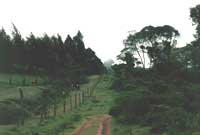 |
RHINO RESCUE TRUST Project Director and Kenya Representative |
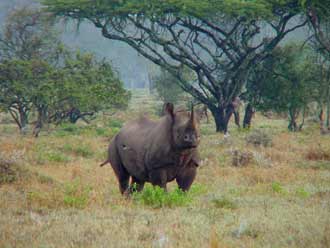 Black Rhino in Lake Nakuru National Park |
In 1985, the poaching of black rhinos in Kenya had reached apocalyptic levels. As a boy, on visits to many of the national parks, I could recall how frequently a rhino would charge out of the undergrowth like an express train causing huge excitement and adrenaline rushes as my father maneuvered the car to avoid collision. Not any more. Thousands had been killed and the few remaining were being pursued relentlessly to satisfy the insatiable demand from the near and far East. |
| Maurice Coreth, a retired professional hunter, decided on a plan to save the few remaining rhinos. Lake Nakuru National Park, at this point no more than a world-renowned bird sanctuary, was in the process of being enlarged. Maurice's plan was to raise sufficient money to erect a rhino-and-poacher-proof electric fence round the 80 kilometer perimeter and then to translocate such rhinos as could be found into the safety of the park. |
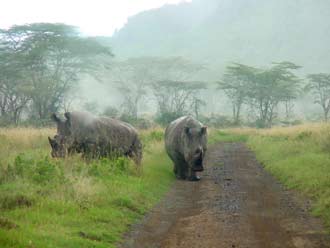 White Rhino in Lake Nakuru National Park |
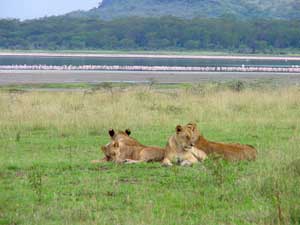 Lion Pride in Lake Nakuru National Park |
Many experts scoffed at the idea but Maurice was not to be deterred and after a few years of vigorous fund-raising, he achieved his aim and proved them wrong. The park became home to a small group of black rhinos and also some whites, which were brought from South Africa. I became involved from the start when Maurice bullied me into donating artwork. Having completed the fence, the Rhino Rescue Trust withdrew to concentrate on other needy projects in Kenya, Zimbabwe and India. |
|
The El Nino weather phenomenon hit Kenya in 1998 with torrents of rain which washed away large sections of LNNP's fence. The wildlife authorities lacked the funds to effect repairs so RRT was recalled to help. The Trust offered to take over the maintenance of the fence and consequently purchased two 4 x 4 vehicles, a tractor and mower, and employed a workforce of eleven men. The damage was repaired. Outposts were manned round the clock around the perimeter and a mobile team was constantly available to repair trouble spots. |
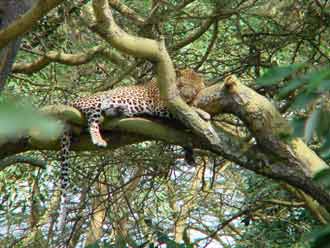 Leopard in Lake Nakuru National Park |
|
RRT also took on the responsibility of re-opening three of the parks defunct boreholes. |
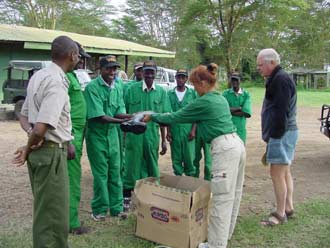 Artist Jane Alcorn providing gum boots for Rhino Rescue Team |
I have lived in the Nakuru area on and off since 1946 when my father first moved to Kenya. As a small boy, I used to stay on the ranch, which later became part of the park. In 1998, I moved back to Soysambu, Lord Delamere's cattle ranch that adjoins LNNP. My father worked there when I was a teenager so I know the area well. In June 2003, I was asked by the RRT trustees to take over as Kenya Representative and Project Director.
|
|
RRT's aims and tasks remain the same and my wife and I spend a day a week in the park supervising our team. We are also involved in fund-raising projects for the park. The current priority for RRT is to raise sufficient money to drill a new borehole at Pwani, a large area of the park which becomes waterless in the dry season. |
|
If you are interested in more information on our work please continue to monitor this page. We will also be creating a seperate website for Rhino Rescue Trust - Kenya that we will update on a regular basis from our home which is just a few miles from the park. You may also write us directly through our email. contact@simoncombesartist.com |
 |
Rhino Ark |
|
In 2002 I painted this depiction of a waterhole in the Aberdare Mountains where Rhino Ark is building a fence to not only to protect the animals and forest but also the surrounding community.
|
|
For the past two years I have participated in this off road fundraising event. |

